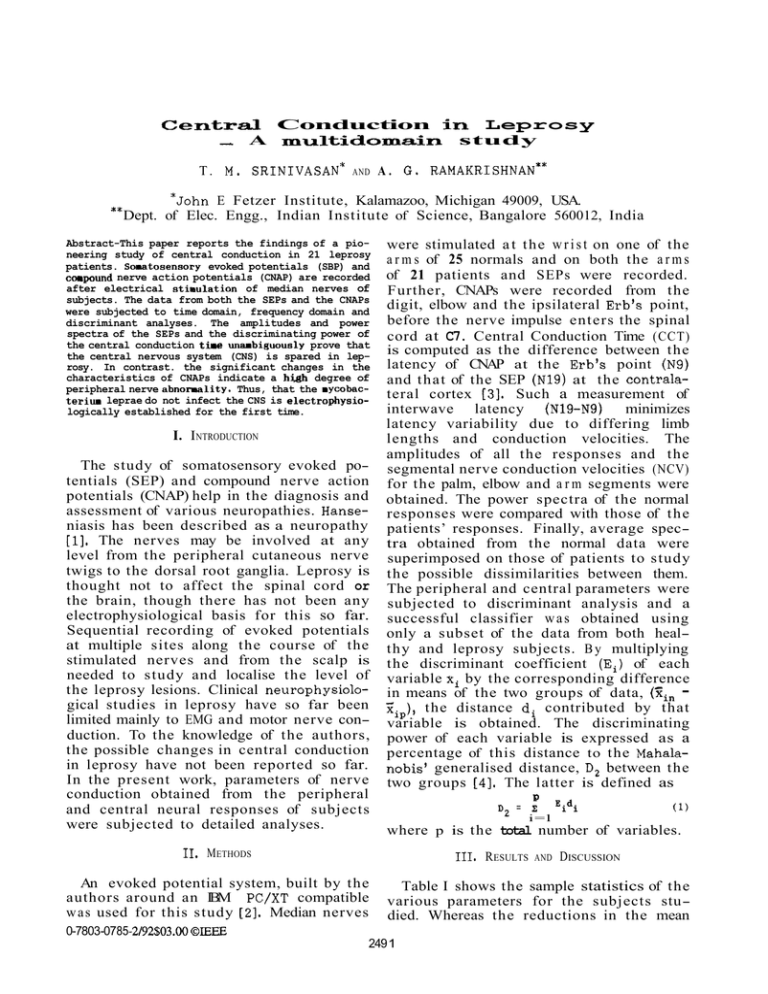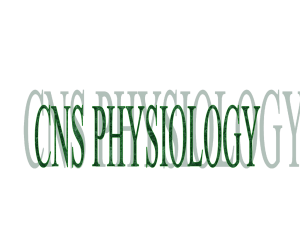- i n Leprosy G,
advertisement

CenCral Conduction i n Leprosy A rnultidornain study - T. M . ** S R I N I V A S A N ~AND A . G, RAMAKRISHNAN** *John E Fetzer Institute, Kalamazoo, Michigan 49009, USA. Dept. of Elec. Engg., Indian Institute of Science, Bangalore 560012, India Abstract-This paper reports the findings of a pioneering study of central conduction in 21 leprosy patients. S-tosensory evoked potentials (SBP) and compound nerve action potentials (CNAP) are recorded after electrical stimulation of median nerves of subjects. The data from both the SEPs and the CNAPs were subjected to time domain, frequency domain and discriminant analyses. The amplitudes and power spectra of the SEPs and the discriminating power of the central conduction time unrubiguously prove that the central nervous system (CNS) is spared in leprosy. In contrast. the significant changes in the characteristics of CNAPs indicate a h i , @ degree of peripheral nerve abnorrality. Thus, that the rycobacterium leprae do not infect the CNS is electrophysiologically established for the first time. I. INTRODUCTION The study of somatosensory evoked potentials (SEP) and compound nerve action potentials (CNAP) help in the diagnosis and assessment of various neuropathies. Hanseniasis has been described as a neuropathy [l]. The nerves may be involved at any level from the peripheral cutaneous nerve twigs to the dorsal root ganglia. Leprosy is thought not to affect the spinal cord or the brain, though there has not been any electrophysiological basis for this so far. Sequential recording of evoked potentials at multiple sites along the course of the stimulated nerves and from the scalp is needed to study and localise the level of the leprosy lesions. Clinical neurophysiological studies in leprosy have so far been limited mainly to EMG and motor nerve conduction. To the knowledge of the authors, the possible changes in central conduction in leprosy have not been reported so far. In the present work, parameters of nerve conduction obtained from the peripheral and central neural responses of subjects were subjected to detailed analyses. were stimulated a t t h e w r i s t on one of the a r m s of 25 normals and on both the a r m s of 21 patients and SEPs were recorded. Further, CNAPs were recorded from the digit, elbow and the ipsilateral Erb’s point, before the nerve impulse enters the spinal cord at C7. Central Conduction Time (CCT) is computed as the difference between the latency of CNAP at the Erb’s point (N9) and t h a t of the SEP (N19)at the contralateral cortex [3]. Such a measurement of interwave latency ( ~ 1 9 - ~ 9 ) minimizes latency variability due to differing limb lengths and conduction velocities. The amplitudes of all the responses and the segmental nerve conduction velocities (NCV) for the palm, elbow and a r m segments were obtained. The power spectra of the normal responses were compared with those of t h e patients’ responses. Finally, average spectra obtained from the normal data were superimposed on those of patients to study the possible dissimilarities between them. The peripheral and central parameters were subjected to discriminant analysis and a successful classifier w a s obtained using only a subset of the data from both healt h y and leprosy subjects. B y multiplying the discriminant coefficient ( Ei) of each variable xi by the corresponding difference in means of the two groups of data, (Xi, Zip), the distance di contributed by that variable is obtained. The discriminating power of each variable is expressed as a percentage of this distance to the Mahalanobis’ generalised distance, D, between the two groups [4], The latter is defined as D2 = B Z Eidi i=l where p is the total number of variables. 11. METHODS 111. RESULTS An evoked potential system, built by the authors around an IBM PC/XT compatible w a s used for this study [21. Median nerves 0-7803-0785-2/92$03 .OO OIEEE (1) AND DISCUSSION Table I shows the sample statistics of the various parameters for the subjects studied. Whereas the reductions in the mean 249 1 amplitudes of t h e elbow and Erb's point responses (Ae and A,,) a r e significant, the reduction in t h e SEP amplitude (A,) is not statistically significant. The marginal reduction in A, of patients is attributable to less excitation reaching t h e Central Nervous System (CNS) from the brachial plexus where t h e CNAP amplitude is significantly (p<.OOl) reduced. I t is seen t h a t the mean value of t h e CCT of patients is almost the same as t h a t for normals. The marginal reduction in the mean C C T of patients is due to the inclusion of v e r y low values of a young patient. Table I also gives the mean values of forearm NCV (Vfa). Since it has been observed t h a t the NCV in all the 3 peripheral segments is significantly reduced, t h e results show t h a t conduction in t h e CNS is not altered due t o leprosy. The power spectra of the distal CNAPs for the healthy subjects a r e v e r y smooth, whereas clear peaks were present at two different frequencies in t h e case of patients. Fig. l displays the average spectra of SEPs for normals and patients. The two spectra a r e practically indistinguishable. The classifier obtained could correctly classify all t h e r e s t of the data from both groups not used for computing t h e discriminant coefficients. Table I1 gives t h e discriminating power for the central and some of t h e peripheral conduction variables. While the powers of A, and Vfa a r e 31% and 14.7%, those of CCT and A, are 0% and -1.2%, t h u s clearly illustrating t h a t t h e values of CCT of a subject cannot be used to differentiate patients from normals. IV. CONCLUSION The mean values of C C T and amplitude of SEP of patients a r e t h e same as those of normal subjects. Further, the average frequency spectra of SEPs of normal subjects TABLE I AMPLITUDES, VELOCITIES AND CENTRAL CONDUCTION TIMES ................................................... Subject Group A A pV p4 A pf "fa m/sec CCT msec 7.3 2.6 4.8 2.6 ,001 3.4 1.1 3.3 1.6 N/S 75.5 4.7 67.2 6.3 .001 8.78 0.49 8.59 0.90 ................................................... Mean (Normals) : S.D. Mean (Patients): S.D. S ig t ) 17.1 5.1 7.4 5.5 ,001 N/S ................................................... 8.0 XHZ FRrmENcl 3.8 BIZ Fig. 1. Comparison of the average spectra of SEPs of normal subjects and patients. and patients a r e indistinguishably identical. The discriminant analysis too has clearly shown t h a t none of the characteristics of t h e SEPs are capable of discriminating between normal and abnormal population. There is however a highly significant reduction in t h e amplitudes of all t h e peripheral potentials and t h e segmental NCVs. Thus these electrophysiological studies conclusively prove t h a t t h e CNS is spared in leprosy. ACKNOWLEDGMENT The authors thank D r . K. S. Rao, former Deputy Director, Central Leprosy Teaching and Research Institute, Chenglepet, South India for providing access to the patients. REFERENCES 111 C. B. Charosky, J . C . Gatti, and J. E, Cardoma, "Neuropathies in Hansen's disease," Int, J. L e p r . , V O ~ . 51, pp. 576-586, 1983. [2] A. G. Ramakrishnan and T. M. Srinivasan, "An integrated system for acquisition, analysis and pattern classification of evoked potentials," unpublished. [3] K . H , Chiappa, S, K . Choi, and R, R, Young, "Short latency somatosensory evoked potentials following median nerve stimulation in patients with neurological lesions," Progress in Clin. Neurophysiol. Ed. Desmedt, J . E . Karger : Basel, V O ~ .7, pp. 264-281, 1980. [ 4 ] B. G . Tabachnick and L. S. Fidell, Ckfng Multi variate statistics. New York: Harper & Row, 1983. 2492




